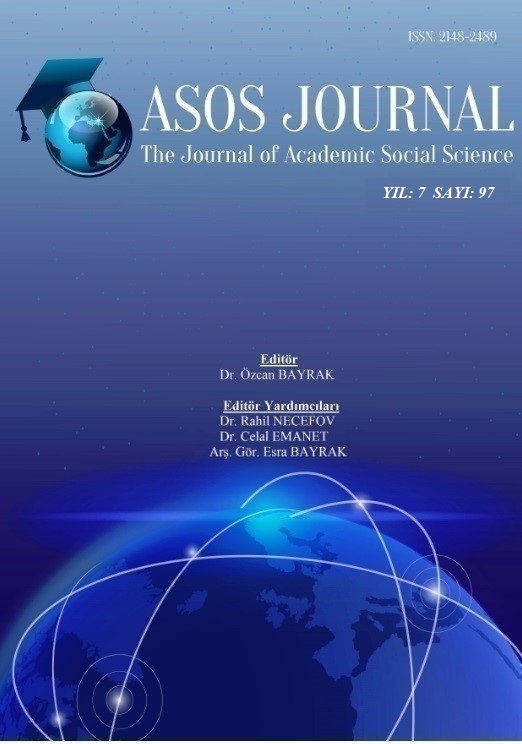AHLAT MEZAR TAŞLARINDA YER ALAN KANDİL MOTİFİNİN İSLAMİYETTEKİ IŞIK VE NUR KAVRAMLARI ÜZERİNDEN DEĞERLENDİRİLMESİ
Author :
Abstract
Mezar taşları kültür ve sanat tarihi açısından önemli verilere sahip birer tarihi belge olma niteliğindedirler. Yapılan araştırmalar, Anadolu’da yaşamış olan her toplumun yaptıkları mezar taşlarında kendi kültürel özelliklerini yansıttıklarını göstermiştir. Türk-İslam sentezini tarihsel ve kültürel anlamda en güzel yansıtan yerlerden biri olan Ahlat, sahip olduğu mezar taşları ile araştırmamıza konu olmuştur. Burada bulunan mezar taşlarının süslemelerindeki motifler, yazılar ve işlemeler, Orta Asya kültürü ile Anadolu kültür özelliklerinin kaynaşması sonucu ortaya çıkmıştır. Ayrıca, İslam dininin hakim olduğu bu bölgede mezar taşlarının süslemeleri de dinin etkisi çerçevesinde gelişmiştir. Bitkisel ve geometrik bezemeler, bordürler, ejder motifi, şamdan ve kandil mezar taşlarının başlıca süsleme öğeleri olarak karşımıza çıkar. Bunun yanı sıra Kuranı-ı Kerim’de yer alan ayetler ve kitabeler de mezar taşları üzerinde yer alır. Kullanılan her bir motif ya da yazı özel bir anlama sahip ve bir amaç için işlenmiştir. Burada İslam özelliklerinin yanı sıra, Orta Asya etkisinin de varlığı hissedilir. Mezar taşlarında kullanılan süsleme ögelerinden, ölen kişinin mezarını ahirete kadar aydınlatması için mezar taşı üzerine işlenen kandil motifi dikkat çekicidir. Aslında bir kullanım aracı olan kandilin mezar taşında, zamanla süsleme öğesine dönüşmesi tamamen inançla ilgili gelişen bir olgudur. Bu olgunun kökeni ve tarihsel anlamları araştırmamızın konusunu oluşturmaktadır.
Keywords
Abstract
Tombstones are historical documents with important data in terms of culture and art history. Research has shown that every society in Anatolia reflects their cultural characteristics in their tombstones. Ahlat, which is one of the most beautiful places reflecting the Turkish-Islamic synthesis in historical and cultural terms, has been the subject of our research with its tombstones. The motifs, writings and embroideries in the ornaments of the gravestones found here are the result of the fusion of Central Asian culture and Anatolian cultural characteristics. In addition, the decorations of tombstones in this region, where Islamic religion is dominant, developed within the framework of the influence of religion. Herbal and geometric decorations, borders, dragon motifs, candlestick and oil lamps are the main decorative elements of the tombstones. In addition, the verses and inscriptions in the Holy Quran are located on the tombstones. Each motif or inscription used has a special meaning and is processed for a purpose. In addition to Islamic characteristics, Central Asian influence is also felt. Among the ornamental elements used in tombstones, the oil lamp motif on the tombstone is striking to illuminate the tomb of the deceased to the hereafter. The fact that the candle, which is actually a means of use, becomes a decorative element in the tombstone is a phenomenon that develops entirely on faith. The origin of this phenomenon and its historical meanings constitute the subject of our research.
Keywords
- Buğrul, H. (2010). ‘‘Van- Bitlis Yöresi XII.-XV. Yüzyıl Mezar Taşlarının İslam Öncesi Orta Asya Türk Mezar Taşları İle Bağlantıları’’. Van: Doktora Tezi, Yüzüncü Yıl Üniversitesi. Sosyal Bilimler Enstitüsü, Sanat Tarihi Anabilim Dalı.
- Çal, H. (2015). ‘‘Türklerde Mezar- Mezar Taşları’’, Ankara: Aile Yazıları/ 8, Aile ve Sosyal Politikalar Bakanlığı.
- Çetin, Y. (2015). ‘‘Ağrı Mezar Taşlarında Form ve Bezeme Unsurları’’. The Journal of Acade- mic Social Science Studies, Doi number:http://dx.doi.org/10.9761/JASSS315, Number: 40 , p. 87-105, Winter I 2015.
- Er, Y. (2004). ‘‘Klasik Arkeoloji Sözlüğü’’. Ankara: Phoenix Yayınevi.
- Eyüboğlu, Z. (2004). ‘‘Türk Dilinin Etimolojik Sözlüğü’’. İstanbul: Sosyal Yayınları.
- Fahri, M. (1987). ‘‘İslam Felsefe Tarihi’’, İstanbul: Şa- to Yayınları.
- İsfahani, H., Muhammedd R. (1986). ‘‘El Müredat fi Garibi’l Kur’an’’. İstanbul.
- İslam Ansiklopedisi (1950), Ankara: Milli Eğitim Basımevi.
- Kalfazade, S. – Ertuğrul, Ö. (1989). “Kandil ve Kandilin Motif Olarak Anadolu Türk Sanatın- daki Kullanımı Üzerine”. İstanbul: Sanat Tarihi Araştırmaları Dergisi, C.2, S.5, s.23-34.
- Karamağaralı, B.(1972). ‘‘Ahlat Mezar Taşları’’, Ankara: Güven Matbaası.
- Kınal, F. (1960). “Kaunos Adak Lambaları”, Ankara: Belleten, Cilt XXXIII, S.130, s.151-159.
- Tanman, B. (2005). ‘‘Osmanlı Toplumunda Tasavvuf ve Sufiler’’, Ankara: Türk Tarih Kurumu.





